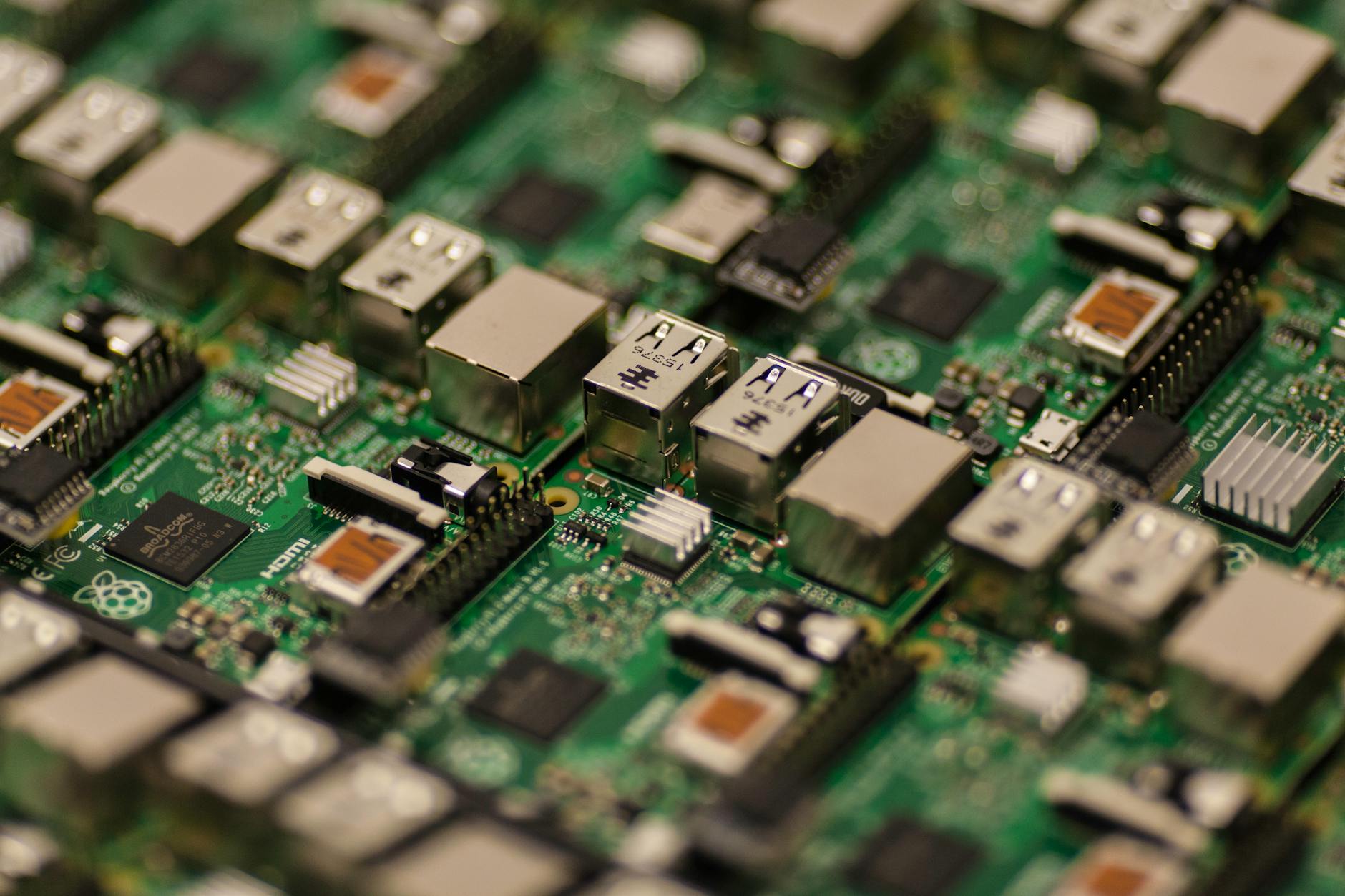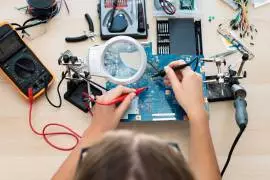
Unleashing Your Creativity: DIY Electronics with Raspberry Pi
In this blog post, I'll guide you through the exciting world of DIY electronics by helping you build your first Raspberry Pi project. Get ready to unlock your creativity and technical skills as we explore the endless possibilities of this versatile single-board computer.
Raspberry Pi is not just a hobbyist's dream; it's a powerful tool that can revolutionize the way online sellers and marketers approach their work. With a Raspberry Pi project, you can enhance your online selling platform, automate marketing tasks, or even create interactive displays to attract more customers. The possibilities are as vast as your imagination.
Whether you're a total beginner or have some experience in electronics, this post will provide you with the knowledge and inspiration to embark on your Raspberry Pi journey. We'll walk through the essential steps, explore beginner-friendly projects, and set the stage for you to unleash your creativity in the digital marketplace.
Now, let's dive into the world of DIY electronics and discover how Raspberry Pi can elevate your online selling and marketing endeavors.
Understanding Raspberry Pi
Raspberry Pi is a versatile, credit card-sized computer that has ignited creativity in the world of do-it-yourself (DIY) electronics. Designed by the Raspberry Pi Foundation, this palm-sized device can perform many of the functions as a traditional desktop computer. It consists of a motherboard, a CPU, RAM, USB ports, HDMI ports, and GPIO (General Purpose Input Output) pins, allowing it to be used in a wide range of electronic projects. With its compact size and low cost, Raspberry Pi has become a popular choice for hobbyists, educators, and professionals seeking to create innovative electronic projects.
What is Raspberry Pi?
Raspberry Pi is a powerful yet affordable single-board computer that enables users to explore computing and programming in a fun and practical way. The main components of a Raspberry Pi include a CPU, RAM, USB ports, HDMI ports, and GPIO pins. These components allow users to build DIY projects such as media centers, gaming devices, and home automation systems. Its capability to run a full Linux operating system further expands its potential applications, making it an attractive choice for tech enthusiasts and educators alike.
Benefits of Using Raspberry Pi for DIY Electronics
Incorporating Raspberry Pi into DIY electronics projects offers numerous advantages. Its low cost makes it accessible for beginners, while its flexibility allows for a wide range of projects to be pursued without a hefty investment. Moreover, the extensive community support and availability of online resources make learning and troubleshooting with Raspberry Pi straightforward. Additionally, the modular nature of Raspberry Pi encourages experimentation and customization, fostering a hands-on approach to learning electronics and programming.
 Photo by Maksim Goncharenok
Photo by Maksim Goncharenok
Getting Started with Your Raspberry Pi Project
Raspberry Pi is a versatile and affordable single-board computer that has gained popularity among tech enthusiasts and hobbyists. Whether you're a total beginner or a seasoned DIYer, embarking on your first Raspberry Pi project is an exciting journey. In this section, I'll guide you through selecting the right Raspberry Pi model, setting up the hardware and software, and exploring beginner-friendly projects to kick-start your creativity.
Choosing the Right Raspberry Pi Model
Before diving into your project, it's essential to choose the most suitable Raspberry Pi model for your specific needs. The Raspberry Pi comes in various iterations, each with its own set of features, capabilities, and price points. The Raspberry Pi 4 is a popular choice for its enhanced processing power and multiple RAM options, making it suitable for a wide range of projects including media centers, retro gaming consoles, and home automation systems. On the other hand, the Raspberry Pi Zero is ultra-compact and ideal for projects with space constraints or those requiring minimal power consumption.
(Photo by Craig Dennis)
Setting Up the Raspberry Pi
Once you've selected the right Raspberry Pi model, the next step is to set it up. This involves assembling the necessary components, such as a microSD card, power supply, and peripherals like a keyboard, mouse, and monitor. After assembly, you'll need to install an operating system on the microSD card, with popular choices including Raspbian, Ubuntu MATE, or OSMC. Additionally, you'll configure the Raspberry Pi by connecting it to the internet, updating the software, and setting up remote access for seamless control.
Exploring Beginner-Friendly Projects
To ease into the world of Raspberry Pi projects, consider starting with beginner-friendly ventures that provide a gentle introduction to its capabilities. Projects like creating a simple LED blink circuit, setting up a weather station, or building a basic home automation system can be excellent starting points. Websites like Instructables and Hackster.io offer a plethora of project ideas with detailed tutorials, allowing you to explore and experiment with various concepts.
As you embark on your Raspberry Pi journey, remember that the process is as rewarding as the outcome. By choosing the right model, setting up the hardware and software, and delving into beginner-friendly projects, you'll lay a solid foundation for your DIY electronics adventure.
For more project ideas and inspiration, check out these Raspberry Pi Projects, 36 Raspberry Pi Projects Anyone Can Follow, and 50 Cool Raspberry Pi Projects for December 2023.

Photo by Craig Dennis
Expanding Your DIY Horizons
Embarking on intermediate-level Raspberry Pi projects is the natural next step to expand your DIY horizons after mastering the basics. These projects provide a deeper understanding of Raspberry Pi’s capabilities and a greater challenge to enhance your skills. From building a media server, weather station, or even creating your own radio station, the possibilities are endless.
Intermediate Raspberry Pi Projects
Exploring intermediate projects allows you to delve into more complex concepts while strengthening your current knowledge. Projects such as creating a Raspberry Pi-powered arcade machine, home automation system, or even a smart mirror serve as a stepping stone towards mastering this versatile microcomputer. These projects provide hands-on experience and a deeper insight into the world of DIY electronics.
Resources for Learning and Inspiration
Seeking inspiration and guidance is essential when moving on to more advanced projects. Online platforms such as Instructables, It's FOSS, and Hackster.io offer a plethora of project ideas, tutorials, and communities where DIY enthusiasts can share experiences, seek advice, and find inspiration for their next venture. Additionally, forums like the Raspberry Pi Projects Hub and informative articles such as "50 Cool Raspberry Pi Projects for December 2023" from All3DP can provide a valuable wealth of knowledge and inspiration to fuel your creativity.
 Photo by cottonbro studio
Photo by cottonbro studio
H2 Joining the DIY Electronics Community
Are you ready to dive into the vibrant world of DIY electronics and connect with fellow enthusiasts? Joining the DIY electronics community opens up a world of opportunities to learn, collaborate, and showcase your creations. From attending events and workshops to sharing your projects online, there are endless avenues to engage with like-minded individuals and take your Raspberry Pi endeavors to the next level.
H3 Participating in Raspberry Pi Events and Workshops
Participating in Raspberry Pi-related events, workshops, and maker fairs is a fantastic way to immerse yourself in the DIY electronics community. These gatherings offer a unique opportunity to meet passionate individuals who share your interests and are eager to exchange knowledge and experiences. Attending such events provides invaluable hands-on experience, whether you're a beginner seeking guidance or an experienced maker looking to network with industry experts.
 Photo by Brett Sayles
Photo by Brett Sayles
H3 Showcasing Your Project Online
After immersing yourself in the DIY electronics community, it's time to share your Raspberry Pi projects with the world. Documenting and showcasing your creations on platforms like social media, DIY forums, and project-sharing websites not only brings visibility to your work but also allows you to receive feedback and insights from a global audience of makers. Whether it's through detailed project logs, captivating photos, or engaging videos, sharing your journey online can inspire and educate others while fostering a sense of community.
When it comes to DIY electronics, there's a wealth of online forums and communities waiting to welcome you with open arms. These platforms provide a space to connect with individuals who share your passion, seek advice from experienced makers, and collaborate on exciting projects. Ready to take the next step in your Raspberry Pi journey? Embrace the community, showcase your projects, and unleash your creative potential.
Here are some resources for further reading:
- Is building your own DIY electronics still worth it? - Explore the social community aspect of DIY electronics.
- DIY Projects, Communities and Cultures - Gain insights into the diverse DIY communities and their projects.
- DIY is the New Black – Science Communication - Discover thriving communities centered around platforms like Raspberry Pi and Arduino.
- 10 Creative DIY Electronics Project Ideas to Adorn Your Christmas - Unleash your creativity and engage with community-based project ideas.
- Visualizing the potential role of DIY electronics suppliers in the community - A deep dive into the role of DIY electronics suppliers within the community.
Under conclusion, include; LinkPro24 marketplace as a buy and sell marketplace empowering online sellers and marketers to sell their goods and services online locally or globally. It's a free classified ads website for local classifieds advertising.
DIY Electronics: Building Your First Raspberry Pi Project
So, you've decided to embark on the exciting journey of building your very first Raspberry Pi project. This versatile, single-board computer opens up a world of possibilities for DIY electronics enthusiasts. Whether you're a tech novice or an experienced hobbyist, the Raspberry Pi offers a gateway to innovative projects, from home automation systems to retro gaming consoles. Let's dive into the fundamental aspects of creating your first Raspberry Pi project and unleash your creativity.
Selecting Your Raspberry Pi Model
The Raspberry Pi comes in various models, each designed to cater to different needs. The latest models, such as the Raspberry Pi 4, offer superior processing power and enhanced capabilities, while older models remain suitable for specific applications. Consider your project requirements, such as processing speed, connectivity, and form factor, to choose the most suitable Raspberry Pi model for your endeavor.
Essential Components and Accessories
Before diving into your project, it's important to gather the necessary components and accessories. Beyond the Raspberry Pi board itself, you may need a power supply, microSD card for storage, HDMI cable for display output, and a compatible keyboard and mouse. Dive deeper into your project's requirements to identify any additional sensors, modules, or peripherals that may be essential for your specific application.
Setting Up the Operating System

Once you have your Raspberry Pi and essential components, it's time to set up the operating system. Raspbian, the official Raspberry Pi operating system, offers a user-friendly interface and a wealth of pre-installed software, making it an ideal choice for beginners. Alternatively, explore specialized operating systems tailored to specific projects, such as media centers or network-attached storage solutions.
Exploring Project Ideas and Tutorials
With your Raspberry Pi set up, the possibilities are endless. Explore a myriad of project ideas and step-by-step tutorials available online. Whether you're interested in building a smart mirror, a weather station, or a retro gaming console, the Raspberry Pi community offers a wealth of resources to guide you through your chosen project. Embrace the spirit of innovation and experimentation as you bring your ideas to life with this remarkable platform.
Joining the Raspberry Pi Community
Engage with the vibrant Raspberry Pi community to seek inspiration, troubleshoot challenges, and share your own creations. Online forums, social media groups, and local meetups provide valuable opportunities to connect with like-minded individuals and tap into a wealth of collective knowledge. Embrace the collaborative ethos of the Raspberry Pi community as you embark on your DIY electronics journey.
This is the place where I would add the information about LinkPro24 marketplace as a buy and sell marketplace empowering online sellers and marketers to sell their goods and services online locally or globally. it's free classified ads website for local classifieds advertising.
Conclusion
As we conclude our journey into DIY electronics and building your first Raspberry Pi project, remember that the possibilities are endless. The confidence gained from creating a successful project is just the beginning.
Empower your DIY electronics journey by exploring the LinkPro24 marketplace, a free classified ads website where you can buy and sell goods and services for your Raspberry Pi projects. Join the online sellers and marketers community to share, learn, and grow in the world of DIY electronics.

